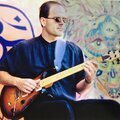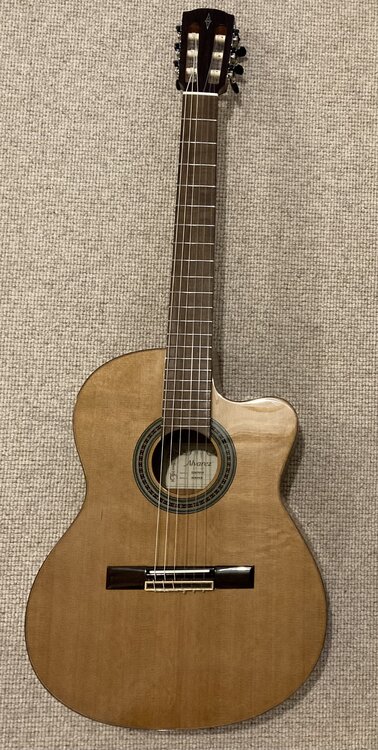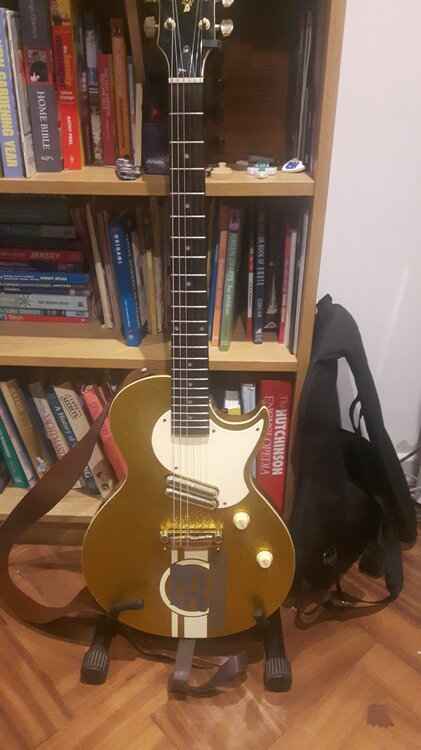-
Posts
1,516 -
Joined
-
Last visited
-
Days Won
315
Content Type
Profiles
Forums
Events
Shop
Posts posted by ezbass
-
-
Sadly, this is impossible to answer. If you can play them beforehand, then it's the one that feels/sounds best to you and makes you want to play it.
-
 1
1
-
-
I imagine it depends on what you're using the GT100 for, in terms of placement. As Boss pedals are known for buffering. I don't imagine you'll suffer too much signal loss either way.
-
21 hours ago, CeeCoz said:
Thanks guys. It just never occurred to me that they would use a piece of wood with a marking like that in it. I would have thought that they would want to keep their maple fretboards looking pretty clean and a piece like that would be rejected.
I had an original run, PRS McCarty, with a lovely flame, maple top that had some of those same streaks.
-
 2
2
-
-
Naturally occurring, sugar sap mark. Maple is prone to this, nothing too worry about.
-
I haven't had any experience of the HB one, but their guitars are pretty decent (I own one of their basses), especially those with the upgraded hardware. I was in a band with a guy who used a Vintage V100 and it was very decent and the brand gets a fair bit of love on GuitarChat. All that being said, it seems that you've actually made your mind up already and saving £100 isn't to be sniffed at, as you could use this to upgrade the pickups and electronics, if needed. Just remember, when it arrives, we all want to see it!
-
 2
2
-
-
YouTube is your friend. Basically, you locate the wires coming from one of the pickups (hopefully just 2 wires, it gets complicated if there are more) and swap them around. If in doubt, take it to a tech.
-
I’ve had an itch to go full circle and acquire a classical guitar. There’s something about the sound of nylon strings that always seems so pleasant to my ears. Then I had a couple of videos come up on my YouTube feed that featured jazz being played on a nylon strung guitars, which pretty much sealed the deal. I didn’t really know what I was looking for, but a cutaway seemed like a good idea and as I had a bass to trade in, that pretty much set the budget. A little browsing on local (for a value of local, still an hour+ driving, each way) guitar shop websites and I settled on trying the Alvarez AC65HCE. This a hybrid model where the neck meets to body at the 14th fret, instead of the 12th and the nut width isn’t quite so wide. Went to Guitar Guitar in Edinburgh , tried it, sounded and felt good to me, so rather than do due diligence by trying some others, I bought it. With the trade in it cost me a whole £40, so I’m well pleased.
What’s that, where are the pics you say? Very well…
Big shout out to the staff at GG, Edinburgh, who couldn’t have been more helpful if they tried. Even after I had parted with my £s, they were quite happy to shoot the breeze about guitars and players. I’d definitely go back, despite the journey.
-
 1
1
-
 1
1
-
-
4 hours ago, owen said:
I checked my Tele by playing one which I knew to be correctly wired. Night and day difference.
Just swap the hot and earth leads over on one of the pickups, all sorted.
-
Something the OP may find interesting, especially the roundup of pros and cons at the end.
-
 1
1
-
-
10 hours ago, owen said:
Thanks for the response. Sorry, I should have clarified. It is a much respected UK luthier who specialises in Rick-alikes. He has loaded it with Retrovibe Toaster pickups so I am presuming it is at the very least in the Rick ballpark.
In which case, buy one and insert it into the guitar of you choice. It might sound a bit different, but it’ll be very much in the same ballpark. Finding a different bridge pickup (should you want one) that couples nicely with it is another journey, but a fun one.
-
The thing is, because this a Rick-alike, that pickup may not be anything like an actual Ric neck pickup other than in looks. Perhaps try to have a go on a real 360 and see if it’s the same.
-
If I were in the market for a combo right now, I’d be all over this - https://www.basschat.co.uk/topic/477611-roland-blues-cube-never-used-minty-condition-model-bc-hot-vb-33w-now-£275/
-
 1
1
-
-
I’ve been in the audience when the guitar players were using Kempers and they sounded great. However, I have heard that on stage experience can be ‘off’ as they lack the ‘feel’ of a valve amp. For my part, I used to use a lot of Tech21 gear (still use their preamps for bass) and never felt that they were lacking in on stage feedback, so I’m I do wonder if a lot of players do a lot of hearing with their eyes. The downside with valve amps and especially vintage ones is the maintenance and their susceptibility to damage when being lugged in and out of vans, etc. in addition, eventually the supply of valves will dry up, I understand, that with the current situation with Russia, valves are harder and, therefore, more expensive to acquire. If it were me, I’d grasp the current modelling nettle and get the box I felt most at home with. This is tinged by having a buddy who uses a Kemper for guitar and bass duties and he loves it. Either that, or find a solid state amp that I really liked the sound of; YMMV.
-
 1
1
-
-
-
27 minutes ago, EdwardMarlowe said:
If you can stretch just a tiny bit over the RRP (should be somewhere selling it cheaper than the £449 quoted on the Fender website, though) - the Limited Edition Squier Classic Vibe 60s Jaguar in silver sparkle would be a nice choice, in that being LE it won't be around forever, so it's a guitar that is sort of tied to a particular Christmas in time as well, which would be nice - https://www.fender.com/en-GB/squier-electric-guitars/jaguar/limited-edition-classic-vibe-60s-jaguar/0374092581.html
Ooh, that Jag looks very tasty!
-
 1
1
-
-
I’d put the univibe before or after the trem pedal and the GE7 after those. As to the comp pedal, that rather depends on if you’re using as an effect (Summers/Gilmour vibe) or just to even things out. If as an effect, after the wah, if as ‘smoother’, just before the delay. But that’s just me, it’s what sounds good that matters and how all the fx play with each other.
-
 1
1
-
-
Looks like B Major to me.
-
 2
2
-
-
2 hours ago, randythoades said:
or maybe even a p90 instead of a normal strat neck pickup.

-
 1
1
-
-
According to Schecter themselves, that guitar comes with a 009-042 set. It is worth noting that not all strings are equal and tension can vary from manufacturer to manufacturer. However, you’d wouldn’t think that there would be much variance in the plain strings.
-
-
Nice one, like it.
-
The Squier Classic Vibes are really good guitars and not just for the money, in fact I think they punch way above their price point. As to whether a Jaguar or Mustang, you hubby has clouded the water with the pic. Both are good and around your budget. Based on the ability to upgrade the hardware in the future, I’d go Jaguar, as they are more readily available and a wider range of upgrades. Also, the Mustang body is quite small and can feel a bit toy like at times (I use a Mustang bass, which is the same body size, and am 6’ ). You could rib him a bit about sending you the wrong photo/giving it the wrong name, if you want to get some clarification. Who are his guitar heroes? This is often a good way to find out what someone wants:Johnny Marr - Jaguar; Kurt Cobain - Mustang (sort of). Hope that helps.
-
 1
1
-
-
-
25 minutes ago, randythoades said:
I have also heard that. I did have an Encore very similar to the one in the original post and it was very nice, certainly for a beginner guitar. I carried on playing it even after I had progressed onto a Fender, it was just as good to my inexperienced ears. I only sold it because I became embarrassed by playing it instead of my Fender.
I am not as worried by that image now and take a great delight in playing my homebuild Strat with Squier neck and a couple of Vintage VZ99 Zip guitars from the mid 2000s, one like a Danelectro with lipstick pickup, and another the same but with a humbucker. Brilliant guitars, irrespective of price and I love it hen people turn their noses up at it and then I play it with the band and you get a grudging shrug of 'it's actually pretty good...'.
So to sumarise, the Encore and Vintage brands are good quality overall and perfectly nice guitars.
Those Zips were a nice guitar and refreshing look, even though still basically an LP Junior.
-
 1
1
-






2 electrics to choose from
in Guitars
Posted
This is definitely something worth considering.